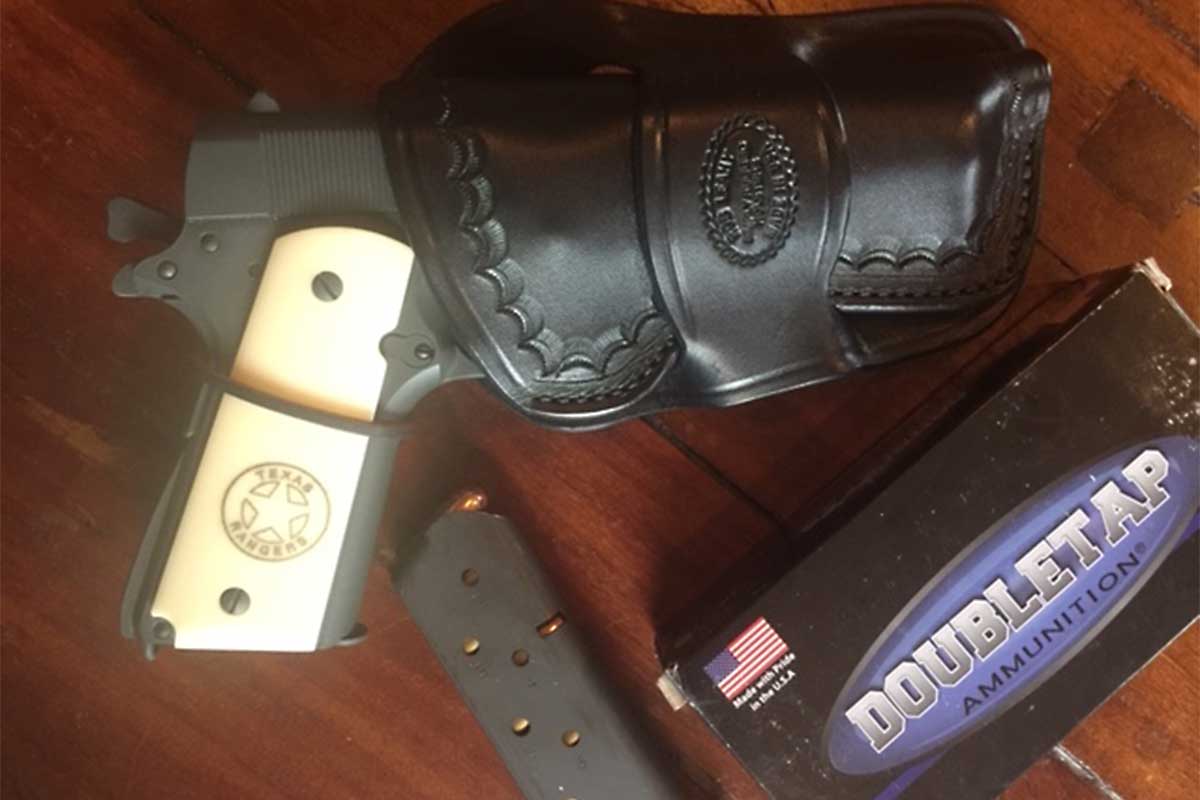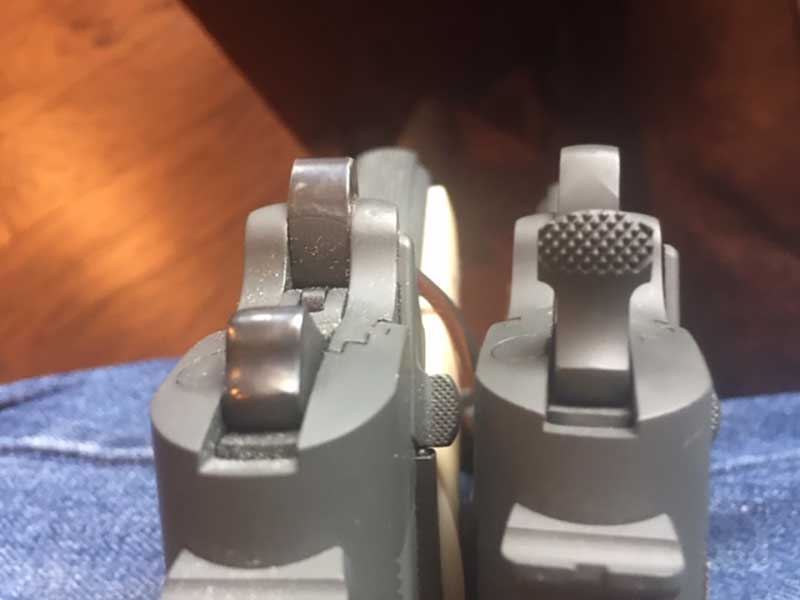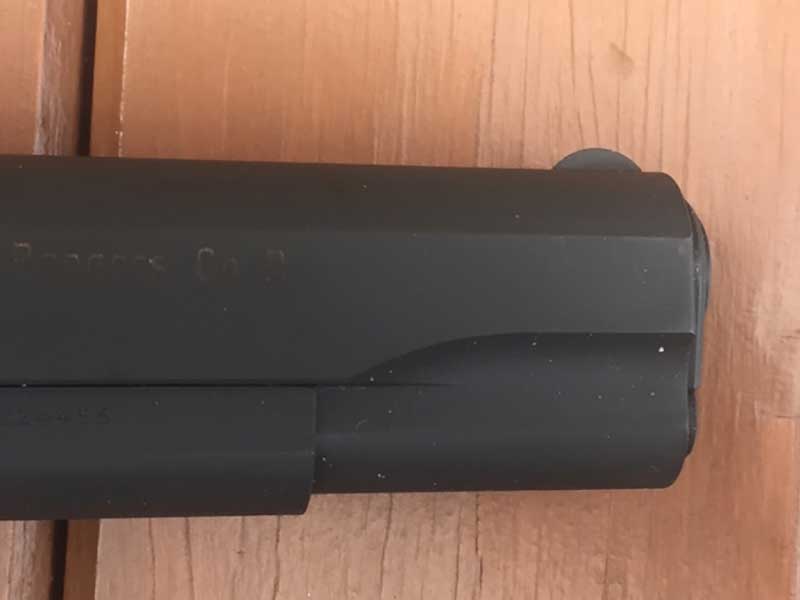
AC-100121-TexasRanger-TR-2-800
In any gathering of shooters there’s usually some talk about the great or greatest gunfighters and crime fighting organizations of all time. The one group that seems to get mentioned most often is the Texas Rangers. Though dwarfed by the number of personnel and size of budgets possessed by numerous Federal agencies, the Rangers surrender nothing to the larger institutions in terms of history and breathtaking encounters.
In fact the Texas Rangers predate many of the Federal institutions by decades going back to the first half of the 19th century to what was literally the dawn of repeating handguns. Since these conversation groups are “gun guys,” the discussions always get around to the weapons used.
During the early days of the Rangers, about the only repeating weapons available were Colt revolvers. Travel forward in time the better part of a century and the Rangers could choose from several good double-action revolvers, the tried and true Colt Peacemaker, and what many still refer to as the world’s greatest fighting handgun: the Colt 1911 semi-automatic pistol.
For those who had grown up with revolvers, which was pretty much everyone, the 1911 took some getting used to. The firepower advantages and reduced reloading speed were almost irresistible, but if there was some feature in the gun that didn’t quite work for him, the Ranger had to figure out and implement a solution for himself. Good gunsmiths were few and far between, particularly in the vast expanses of Texas where Rangers had to work. The thinkers and the tinkerers flocked to the big pistol; mere mortals stayed with revolvers!

Start with a well-made copy of a Model 1911A1 like this one from Tisas, add a few home-brewed custom touches, and the result can be a personalized, highly effective fighting handgun.

A good gun needs a good home, like this holster from Rob Leahy at Simply Rugged. And if you’re going to dress up your gun, why not have Rob put some custom touches on the new house?

Whether the original short trigger is bad or good depends strictly on whether or not it fits your hand. My stubby trigger finger loves it!
SDS IMPORTS
One of the guys frequently in my gun discussion gatherings is Dave Biggers, VP Sales and Marketing for SDS Imports. SDS Imports offers some extremely well made and affordable 1911s made in Turkey by Tisas. One of their models is an excellent copy of the Model 1911A1 U.S. Army. Yup, it’s like what our Army issued in WW1.
Being a native Texan with a passionate interest in all things “Texas Rangerish,” Dave took a factory 1911A1 and started making some home gunsmithing type mods to the pistol that would make it more suitable and efficient for his personal use and for everyday carry.
His baseline role model was an imagined Ranger from the mid-20th century living in a rural part of Texas and living on a working man’s salary. While we were at Gunsite together and when he wasn’t looking, I borrowed it!
The most obvious change to the gun is the faux ivory stock panels with “Texas Rangers” etched on each panel. My first thought was that this was clearly more ornamental than functional. My second thought was that given the tough guy reputation of the Texas Rangers, a visible brand on your carry gun might give second thoughts to anyone who was considering rude and threatening behavior!
Almost as obvious as the ivory panels is the leather thong tied around the grip and encompassing the grip safety. At first glance, the leather looks a bit Rube Goldberg, but it does keep the safety pressed against the backstrap in the fire position. I won’t get into the 100+ years of arguments regarding the 1911’s grip safety, but it’s a known fact that many shooters fail to reliably de-activate the grip safety with their normal shooting grip.
Jeff Cooper wrote an article on this subject in the late 20th century and authorized the Gunsite smithy to modify student guns by pinning the safety in the “off” position. For the self-educated home gunsmith, the leather thong is much simpler than drilling and pinning.

The original hammer (left) has been seriously bobbed an alteration that successfully eliminates “hammer bite” for most shooters. The tradeoff is that the gun is very difficult, if not impossible, to cock or unlock with just the thumb of your shooting hand.

Front and rear sights are small, but the square notch and blade allow for precise shot placement as long as there is sufficient ambient light for your eyes.

Given the historic reputation of the Texas Rangers, a glimpse of this logo on the stock panels may be all it takes to end a potential threat. And as they teach at Gunsite Academy, “The only good gunfight is the one you avoided!”

For over 100 years the classic 1911 loaded with 230-grain ball ammo like this offering from DoubleTap has resolved many heated discussions. It still works!”
The square knot in the leather thong is on the left hand side of the grip and, quite frankly, looks rather silly and obtrusive. Surprisingly, the strap provides an additional useful function. When firing two-handed, the base of my support hand thumb presses against the knot which provides some additional non-slip gripping surface to help control recoil.
On the right side of the grip, the thong is directly under my middle finger which provides the strongest part of my shooting hand grip. Besides being a tactile reference point, it assists in providing resistance to slippage caused by recoil. Upon shooting the gun a bit, I changed my rating of the thong from “silly” to “kinda cool!” As a cautionary note, you might check the tension of the leather strap occasionally and perhaps tighten it to insure the grip safety remains fully deactivated.
The hammer had received some serious attention from Dave. When shooting 1911s with the old style narrow grip safety, many shooters experience “hammer bite” in the web of their shooting hand when the slide cycles. This is particularly true if one has large, meaty hands and was the cause for creation of the beaver tail grip safety.
The wide, serrated spur on the hammer had been completely removed on the Ranger gun leaving just a nub extending slightly behind the rear of the slide. The back of the nub had been deburred or rounded to insure there were no sharp edges exposed. It worked. When the gun cycles, the modified hammer is too short to reach the web of the shooting hand: no bite.
The downside was that I was unable to cock or release the hammer with the thumb of either hand. While I like having the option of manipulating the hammer by itself, it’s an option I would surrender to eliminate hammer bite when shooting.
Over the decades, numerous other changes have been made to “Old Slabsides” to improve performance. These include things like more visible adjustable sights, longer triggers, flared mag wells and of course, various accurizing techniques.
I’ve found that the small, fixed sights on the “as issued” Tisas 1911A1, are quite capable of making precise hits as long as there is adequate light. With regards to adjustable sights, keep in mind that standard ammo of the day was 230-grain ball, and as long as you stay with a bullet of that weight, the sights shouldn’t need changing.
For me, the original short trigger is pretty much perfect. Plus the Tisas already has a slightly beveled magazine well that facilitate reloads. In terms of accuracy, remember that this is a defensive handgun built for self-defense, not bullseye shooting. Groups of three to four inches at 25 yards are more than adequate; it’s 100% reliability that’s most important.
I believe the Marine Corps specification for accuracy in a procurement for 1911s a few years back was six at 25 yards. In the guns I’ve handled, there is practically no play in the slide to frame fit, and absolutely no barrel movement when the gun is in battery.
If you have a different vision of what a Texas Ranger 1911 should be for you, go for it. On this gun, Dave limited himself to modifications that could be accomplished inexpensively with some simple home gunsmithing skills and tools. If you feel there was some bias on his part in choosing a Tisas for a baseline gun, keep in mind that this is a well-made, all steel copy of a classic handgun that retails for under $400.00.
If you have skills and tools that encourage you to go beyond basic changes, I will applaud your efforts. If you are, or were, a Texas Ranger and you have a different view of the perfect Texas Ranger gun, I totally yield to your judgement!
GUNSITE
www.gunsite.com
SDS IMPORTS
www.sdsimports.com
SIMPLY RUGGED HOLSTERS
www.simplyrugged.com














